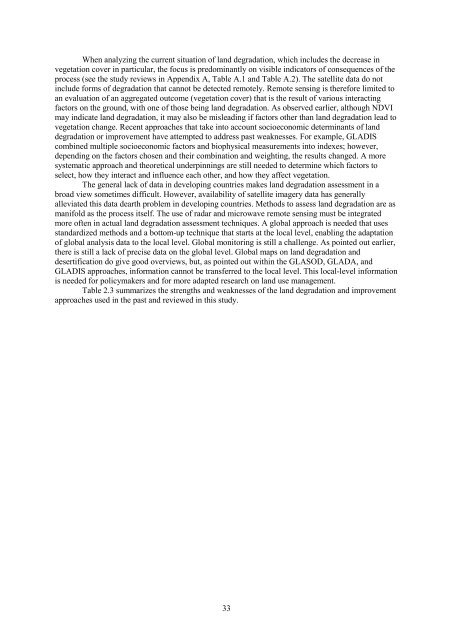The Economics of Desertification, Land Degradation, and Drought
The Economics of Desertification, Land Degradation, and Drought
The Economics of Desertification, Land Degradation, and Drought
You also want an ePaper? Increase the reach of your titles
YUMPU automatically turns print PDFs into web optimized ePapers that Google loves.
When analyzing the current situation <strong>of</strong> l<strong>and</strong> degradation, which includes the decrease in<br />
vegetation cover in particular, the focus is predominantly on visible indicators <strong>of</strong> consequences <strong>of</strong> the<br />
process (see the study reviews in Appendix A, Table A.1 <strong>and</strong> Table A.2). <strong>The</strong> satellite data do not<br />
include forms <strong>of</strong> degradation that cannot be detected remotely. Remote sensing is therefore limited to<br />
an evaluation <strong>of</strong> an aggregated outcome (vegetation cover) that is the result <strong>of</strong> various interacting<br />
factors on the ground, with one <strong>of</strong> those being l<strong>and</strong> degradation. As observed earlier, although NDVI<br />
may indicate l<strong>and</strong> degradation, it may also be misleading if factors other than l<strong>and</strong> degradation lead to<br />
vegetation change. Recent approaches that take into account socioeconomic determinants <strong>of</strong> l<strong>and</strong><br />
degradation or improvement have attempted to address past weaknesses. For example, GLADIS<br />
combined multiple socioeconomic factors <strong>and</strong> biophysical measurements into indexes; however,<br />
depending on the factors chosen <strong>and</strong> their combination <strong>and</strong> weighting, the results changed. A more<br />
systematic approach <strong>and</strong> theoretical underpinnings are still needed to determine which factors to<br />
select, how they interact <strong>and</strong> influence each other, <strong>and</strong> how they affect vegetation.<br />
<strong>The</strong> general lack <strong>of</strong> data in developing countries makes l<strong>and</strong> degradation assessment in a<br />
broad view sometimes difficult. However, availability <strong>of</strong> satellite imagery data has generally<br />
alleviated this data dearth problem in developing countries. Methods to assess l<strong>and</strong> degradation are as<br />
manifold as the process itself. <strong>The</strong> use <strong>of</strong> radar <strong>and</strong> microwave remote sensing must be integrated<br />
more <strong>of</strong>ten in actual l<strong>and</strong> degradation assessment techniques. A global approach is needed that uses<br />
st<strong>and</strong>ardized methods <strong>and</strong> a bottom-up technique that starts at the local level, enabling the adaptation<br />
<strong>of</strong> global analysis data to the local level. Global monitoring is still a challenge. As pointed out earlier,<br />
there is still a lack <strong>of</strong> precise data on the global level. Global maps on l<strong>and</strong> degradation <strong>and</strong><br />
desertification do give good overviews, but, as pointed out within the GLASOD, GLADA, <strong>and</strong><br />
GLADIS approaches, information cannot be transferred to the local level. This local-level information<br />
is needed for policymakers <strong>and</strong> for more adapted research on l<strong>and</strong> use management.<br />
Table 2.3 summarizes the strengths <strong>and</strong> weaknesses <strong>of</strong> the l<strong>and</strong> degradation <strong>and</strong> improvement<br />
approaches used in the past <strong>and</strong> reviewed in this study.<br />
33

















